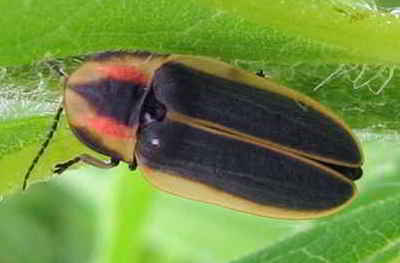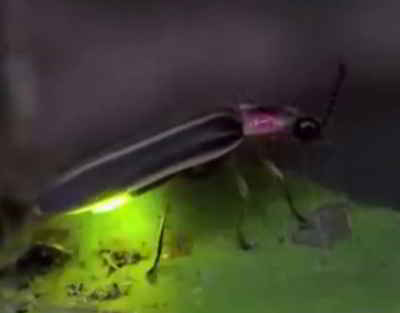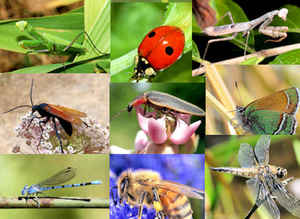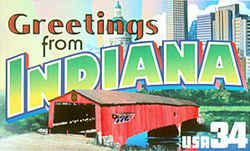Indiana State Insect
Say's Firefly (Angled Candle Firefly)
(Pyractomena Angulata)
Adopted on March 23, 2018.
Say’s Firefly became Indiana’s state insect when legislation proclaiming it as such was signed by Governor Eric Holcomb on March 23, 2018.
Indiana was one of only three states that did not have a state insect. The Say’s Firefly is native to North America, the United States, and Indiana. An effort the the Say’s Firefly the state insect began in 1996, when a bill was placed before the Indiana Legislature. It was approved by the House but never came up for vote in the Senate. Maggie Samudio, Teacher Gr. 2 Room 23 Cumberland Elementary West Lafayette, IN for the past 4-years, persevered to make this happen. Governor Holcomb signed the bill on March 23, 2018 in front of 710 K-3 students at the elementary school .
He was surrounded by the bill author Sen. Ron Alting, R-Lafayette, and bill sponsors Rep. Sally Siegrist, R-Lafayette, and Rep. Sheila Klinker, D-Lafayette. He signed the bill with Cumberland student Kayla Xu, one of the first "lobbyists" for the bill. Since the 2014-2015 school year, elementary school students have been pushing to pass legislation giving Indiana a state insect. That was when Xu was doing a school project and realized Indiana was one of three states that did not have one.
Indiana State Insect: Say's Firefly

These interesting insects really aren't flies at all, but rather beetles from the family Lampyridae. Lampyridae is of Greek origin and is from the same root which gave us the word lamp. These luminescent beetles are the very envy of physicists around the world, because of their ability to produce "cold light". Light production in these creatures is very complex, and still not completely understood.
Fireflies play an important role in nature beyond providing pyrotechnics.
They loosen soil, allowing oxygen, sunlight and water to penetrate. They
maintain balance by eating impressive quantities of food while in the larval
form. Although toxic to many potential diners, they are eaten by spiders,
frogs and other insects.They also provide beauty and entertainment, even
serving as a source for exercise while being pursued by children and
fun-loving adults on summer evenings.
Also commonly known as lightning bugs, they are neither flies nor true bugs,
but are beetles belonging to the family Lampyridae. Very few have common
names. Most are known only by their scientific name.
Characteristics of the Indiana Say's Firefly
The genus in which Say placed this species was Lampyris, but, as is often the case with species named long ago, angulata has since been placed in a different genus, in this case, Pyractomena. Say's firefly is one of about 175 species of fireflies in the United States.
Identfication:
Head: Black, sometimes with dull reddish-orange between eyes.
Antenna: Black, thin; 11 segments on both male and female. 1st segment yellowish.
Thorax (Pronotum): Wide, shield-shaped, tip squared; ridge
or raised line down middle of thorax; from mid-thorax to tip (front end) it
slopes downward (more visible from side view).
Thorax has black middle patch, narrowing to a point at front tip; on each
side of black mostly yellow with rose patch next to the middle black patch.
Outside edges have a black stripe than narrows to a point at or very near to
lower margin. Underside of thorax rose (orangish-red).
Wings (Elytra): Blackish-brown. Outside margins yellow, very wide at base and along side edges, narrowing at tip and narrow yellow along inside of each wing (suture down middle of wings). Wings also have two faint ridges, sometimes slightly lighter colour. At middle of base margin, a small, shiny black triangle (scutellum).
Legs: Thighs (femora) yellowish at base, rest black. Shins streaked with yellowish. Feet black
Abdomen: Top side has pinkish-brown streak inward on
each side, running the length of the abdomen. Segments are white tipped on
lower margin outside edge. Female tip usually extends past wing tips.
Underside of female more yellowish-black, with a yellow line on lower margin
of each segment; last segment before tip yellow – flashes amber. Underside
of male black with last 2 segments before tip yellow – flashes amber.
Size: 7.5 to 14 mm.
Habitat: Wet forests and marshy areas.
Food: Adults have been recorded as not feeding, but found
feeding on Milkweed, Sumac, Dogwood, Yarrow and even Astilbe (non-native)
flowers in Wheatley, Ontario.
Flight Time: June to early July
Life Cycle: Although recorded as nocturnal, frequently
observed and mating during the day. Mating from late June to early July.
Larvae reported to feed on snails and slugs (gastropods).
Indiana Law
HOUSE BILL No. 1186
A BILL FOR AN ACT to amend the Indiana Code concerning general provisions.
Whereas, insects constitute 80% of the world's animal species and are
critical to the ecological balance of our planet as decomposers, recyclers,
pollinators of flowering plants, and an important food source for many
animals and even some plants;
Whereas, the insect known as a "firefly" or "lightning bug" is neither a fly
nor a bug but a soft-bodied beetle that produces light through a complex
chemical reaction in special cells near the end of its abdomen;
Whereas, spectacular nighttime displays of the flashing lights of fireflies
are common from June through September in the croplands, roadsides,
grasslands, and forests of the eastern United States from the Missouri River
to the Atlantic Ocean;
Whereas, male fireflies flash their lights in a series of short or long
bursts to impress female fireflies, and receptive females respond with
flashes of their own;
Whereas, Hoosiers have long enjoyed the beauty and mystique of firefly
displays, which inspired Indiana-born poet James Whitcomb
Riley to write:
"The fireflies, like golden seeds, Are sown about the night.";
Whereas, Thomas Say, an eminent naturalist who lived and worked in New
Harmony in Posey County and is considered the father of American entomology,
named and described "Say's Firefly" in 1824; and
Whereas, the designation of a state insect would provide a unique teaching
opportunity for educators and a point of pride for citizens of Indiana:
Therefore,
Be it enacted by the General Assembly of the State of Indiana:
SECTION 1. IC 1-2-15 IS ADDED TO THE INDIANA CODE AS
A NEW CHAPTER TO READ AS FOLLOWS [EFFECTIVE JULY
1, 2018]:
Chapter 15. State Insect
Sec. 1. Pyractomena angulata, commonly known as "Say's
Firefly", the species of firefly first described by Thomas Say of
New Harmony, Indiana, who is known as the father of American
entomology, is designated as the official state insect of Indiana.
Taxonomic Hierarchy: Say's Firefly
Kingdom: Animalia (Animals)
Phylum: Arthropoda (Arthropods)
Subphylum: Hexapoda (Hexapods)
Class: Insecta (Insects)
Order: Coleoptera (Beetles)
Suborder: Polyphaga (Water, Rove, Scarab, Long-horned, Leaf and Snout Beetles)
Infraorder: Elateriformia Crowson,
1960
Superfamily: Elateroidea (Click, Firefly and Soldier Beetles)
Family: Lampyridae (Fireflies)
Subfamily: Lampyrinae
Tribe; Cratomorphini Green, 1948
Genus; Pyractomena
Species: Pyractomena angulata
Butterflies, and Bugs








